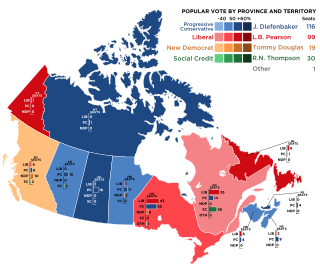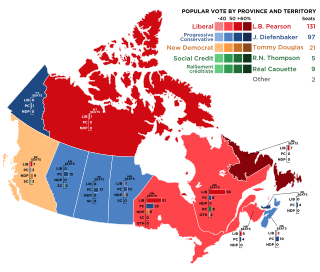
The 2000 Canadian federal election was held on November 27, 2000, to elect members to the House of Commons of Canada of the 37th Parliament of Canada. Prime Minister Jean Chrétien's Liberal Party won a third majority government.

The 1997 Canadian federal election was held on June 2, 1997, to elect members to the House of Commons of the 36th Parliament of Canada. Prime Minister Jean Chrétien's Liberal Party won a second majority government. The Reform Party replaced the Bloc Québécois as the Official Opposition.

The 1993 Canadian federal election was held on October 25, 1993, to elect members to the House of Commons of the 35th Parliament of Canada. Considered to be a major political realignment, it was one of the most eventful elections in Canada's history. Two new regionalist parties emerged, finishing second and third in seat count. Most notably, the election marked the worst defeat for a governing party at the federal level and the worst ever suffered by a governing party in the Western democratic world. The Liberal Party, led by Jean Chrétien, won a majority government, defeating the governing Progressive Conservative Party in a landslide.

The 2004 Canadian federal election was held on June 28, 2004, to elect members to the House of Commons of Canada of the 38th Parliament of Canada. The Liberal government of Prime Minister Paul Martin lost its majority but was able to continue in office as a minority government after the election. This was the first election contested by the newly amalgamated Conservative Party of Canada, after it was formed by the two right-of-centre parties, the Progressive Conservative Party and the Canadian Alliance.
The Ontario Liberal Party is a political party in the province of Ontario, Canada. The party has been led by Bonnie Crombie since December 2023.

The Ontario New Democratic Party is a social democratic political party in Ontario, Canada. The party sits on the centre-left of the political spectrum and currently forms the Official Opposition in Ontario following the 2018 general election. It is Ontario’s provincial wing of the federal New Democratic Party.

The 1984 Canadian federal election was held on September 4, 1984, to elect members to the House of Commons of the 33rd Parliament of Canada.

The 1962 Canadian federal election was held on June 18, 1962, to elect members of the House of Commons of Canada of the 25th Parliament of Canada. The governing Progressive Conservative (PC) Party won a plurality of seats in this election, and its majority government was reduced to a minority government.

The 1963 Canadian federal election was held on April 8, 1963 to elect members of the House of Commons of Canada of the 26th Parliament of Canada. It resulted in the defeat of the minority Progressive Conservative (Tory) government of Prime Minister John Diefenbaker, with the Liberals returning to power for the first time in 6 years, where they would remain for twenty of the next twenty-one years. For the Social Credit Party, despite getting their highest ever share of the vote, the party lost 6 seats compared to its high-water mark in 1962.

The 1965 Canadian federal election was held on November 8, 1965 to elect members of the House of Commons of Canada of the 27th Parliament of Canada. The Liberal Party of Prime Minister Lester B. Pearson was re-elected with a larger number of seats in the House. Although the Liberals lost a small share of the popular vote, they were able to win more seats, falling just short of a majority.

The 1990 Ontario general election was held on September 6, 1990, to elect members of the 35th Legislative Assembly of the province of Ontario, Canada. The governing Ontario Liberal Party led by Premier David Peterson was unexpectedly defeated. Although the Peterson government, and Peterson himself, were very popular, he was accused of opportunism in calling an election just three years into his mandate. In a shocking upset, the New Democratic Party (NDP), led by Bob Rae, won a majority government. This marked the first time the NDP had won government east of Manitoba, and to date the only time the NDP formed the government in Ontario.

The 2006 Canadian federal election was held on January 23, 2006, to elect members to the House of Commons of Canada of the 39th Parliament of Canada.

Thornhill is a federal electoral district in Ontario, Canada, that has been represented in the House of Commons of Canada since 1997. It covers its namesake Thornhill neighbourhood, which is split between the Cities of Vaughan and Markham. The Vaughan portion also includes parts of the city east of Highway 400 and south of Rutherford Road, including the largely industrial district of Concord and Vaughan's planned downtown; Vaughan Metropolitan Centre. The part in the City of Markham is restricted its portion of Thornhill itself west of Bayview Avenue. The riding was created in 1996 and the east end of the riding was split off into other ridings in 2012.

The 39th Canadian federal election was held on January 23, 2006.
The New Democratic Party is a federal political party in Canada. Widely described as social democratic, the party sits at the centre-left to left-wing of the Canadian political spectrum, with the party generally sitting to the left of the Liberal Party. The party was founded in 1961 by the Co-operative Commonwealth Federation (CCF) and the Canadian Labour Congress (CLC).

The 41st Canadian federal election was held on May 2, 2011. It resulted in a Conservative majority government under the leadership of Prime Minister Stephen Harper. It was the third consecutive election win for Harper, and with 166 of 308 seats, giving them a majority government for the first time in their eight-year history. It was also the first right-of-centre majority government since the Progressive Conservatives won their last majority in 1988. The Conservative Party won 39.62% of the popular vote, an increase of 1.96%, and posted a net gain of 24 seats in the House of Commons.
The 42nd Canadian federal election was held on October 19, 2015. The incumbent Conservative Party of Canada of Prime Minister Stephen Harper, in office since 2006, was defeated by the Liberal Party of Canada under the leadership of Justin Trudeau. The Liberals rebounded from third place in the House of Commons with 36 seats to a strong majority government with 184 of the 338 seats in the expanded Commons. The Liberals picked up 148 seats, easily the biggest numerical increase for a Canadian party since Confederation.
The 2019 Canadian federal election was held on October 21, 2019, to elect members of the House of Commons to the 43rd Canadian Parliament. The Liberal Party of Canada, having previously held a majority of the seats in the House, was returned with a minority of the seats, while the Conservative Party of Canada gained fewer seats than expected and the Bloc Québécois saw its standing revived in Quebec.
The 2021 Canadian federal election was held on September 20, 2021, to elect members of the House of Commons to the 44th Canadian Parliament. The Liberal Party of Canada was returned once more with a minority of the seats, and the composition of the House saw very little change.

















